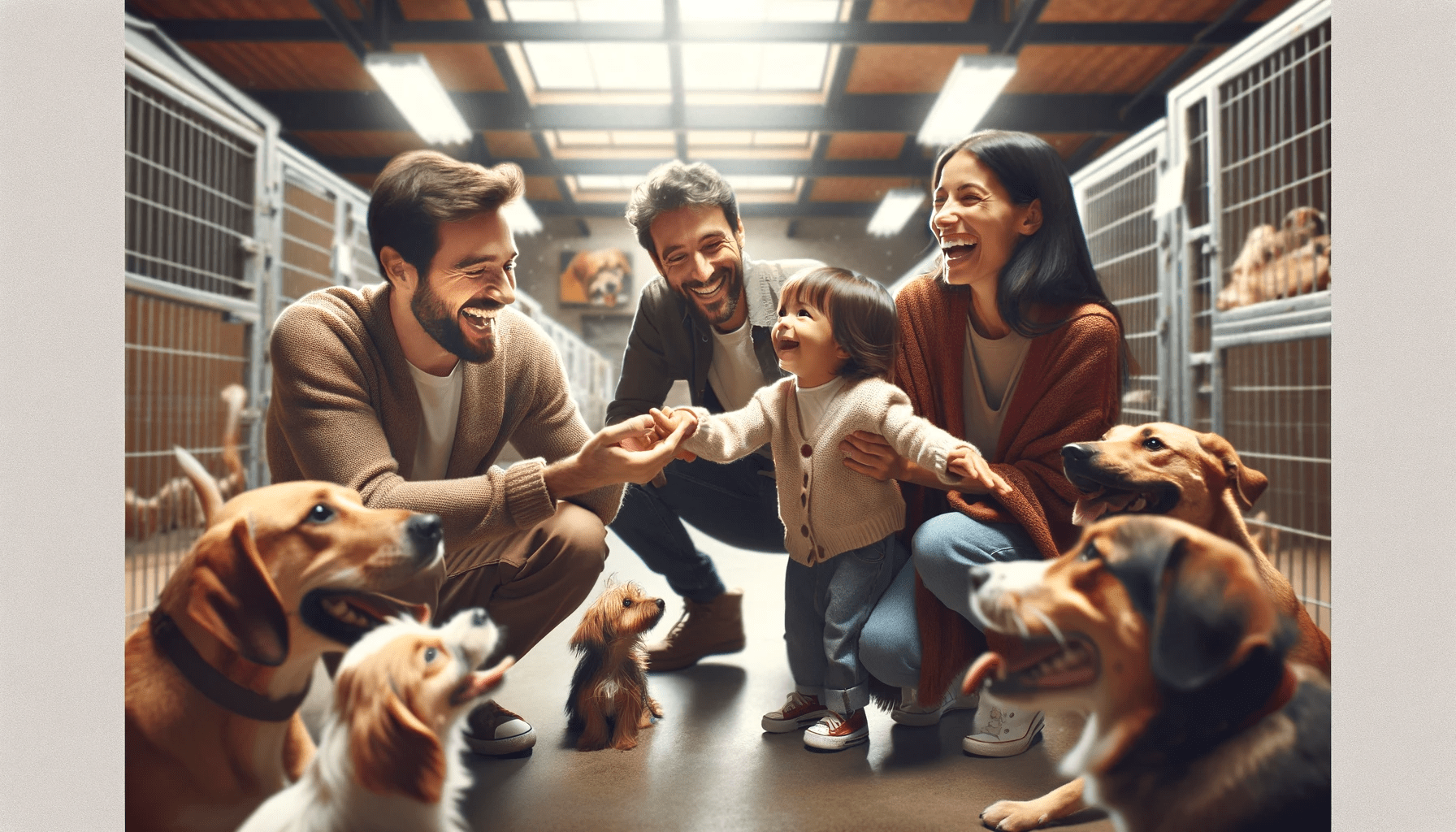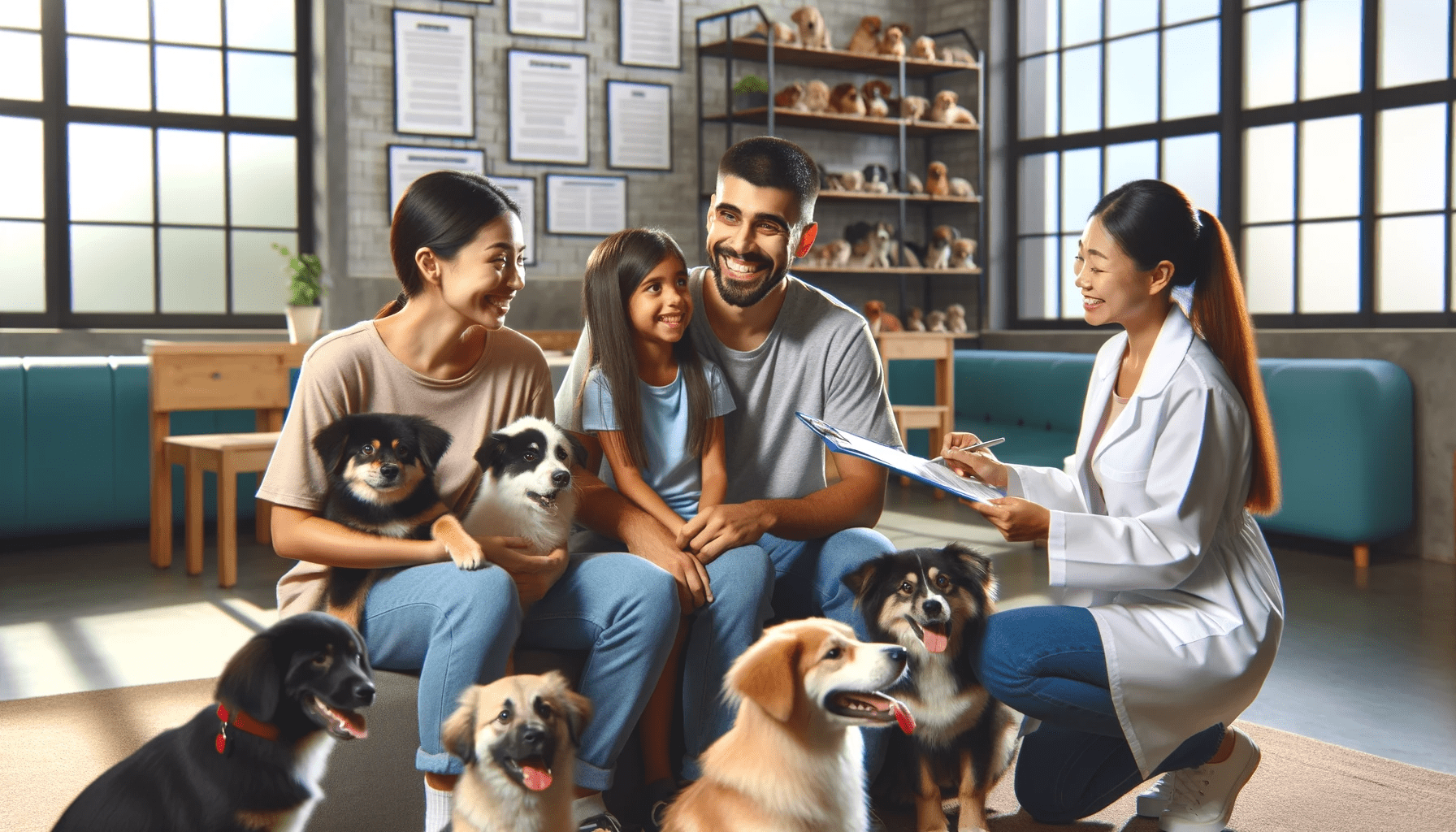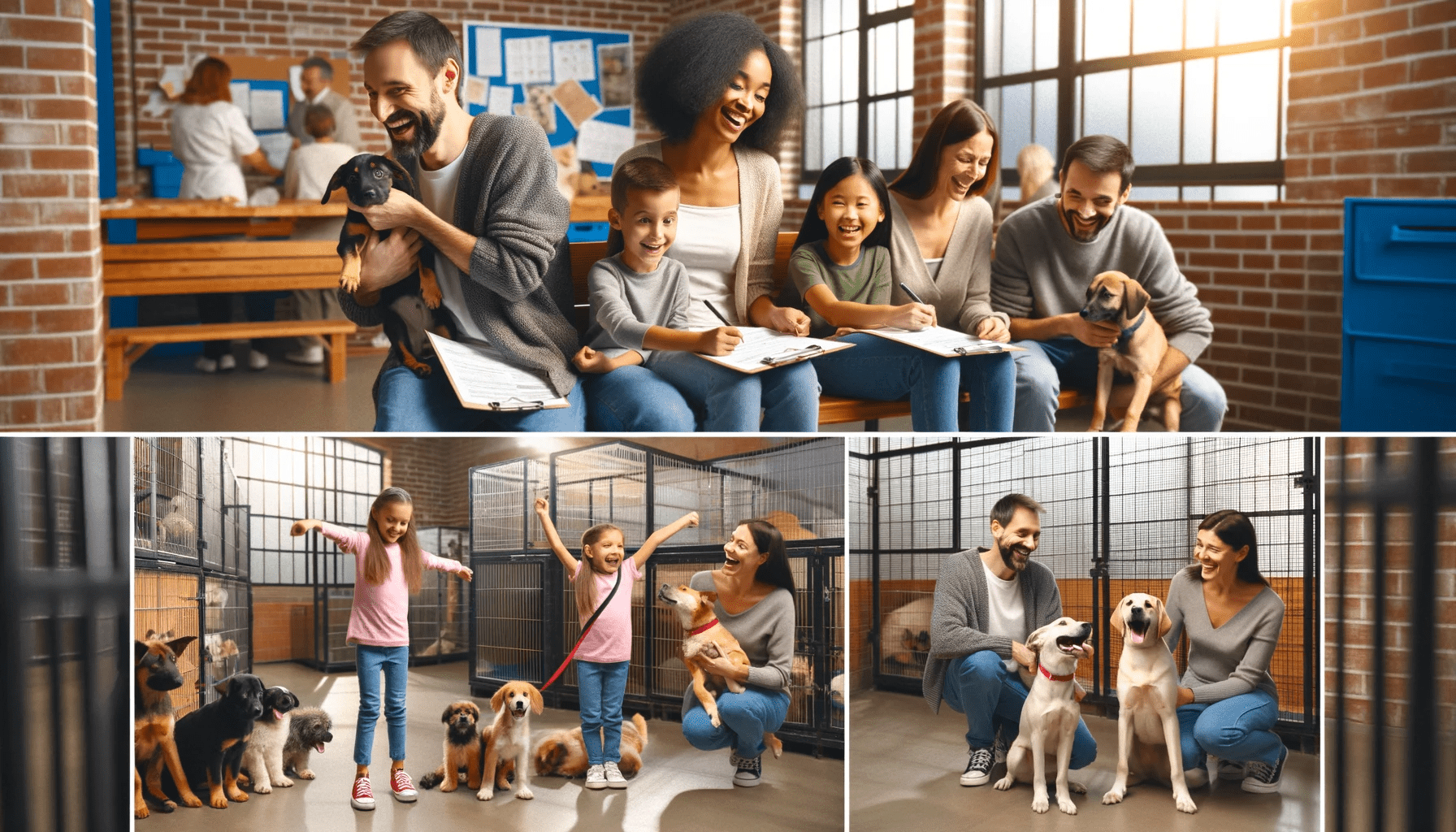Are you bringing home a new furry friend? Introducing your adopted dog to your existing pets can be a delicate process. But fear not, we’ve got you covered with the 7 best strategies to ensure a smooth transition.
From creating a safe space to gradually introducing scents and sounds, these proven techniques will help foster positive relationships.
With careful supervision and professional guidance if needed, you’ll be well on your way to building a harmonious pet family.
Key Takeaways
- Select a comfortable and secure location for introductions.
- Gradually introduce scents and sounds associated with the new dog.
- Familiarize the adopted dog with existing pets’ scents and sounds.
- Use positive reinforcement and rewards to encourage acceptance and bonding.
Set up a Safe and Neutral Space
To ensure a smooth introduction between your newly adopted dog and your existing pets, it’s important to set up a safe and neutral space for them to meet. Creating a peaceful environment is crucial to promote positive interactions and minimize any potential conflicts.
Start by selecting a location where all pets can feel comfortable and secure. It can be a neutral territory, such as a park or a fenced backyard, where none of the animals have established dominance.
Before introducing the pets, make sure to prepare the space by removing any potential hazards or triggers that may cause stress or aggression. This includes toys, food bowls, or any personal items that may lead to territorial behavior.
Gradual introduction techniques should be employed to allow the animals to become acquainted at their own pace. Begin with short and supervised meetings, gradually increasing the duration as they become more comfortable with each other.
During the initial introductions, it’s important to closely monitor their body language and behavior. Look for signs of tension, fear, or aggression, and be ready to intervene if necessary. Keep interactions positive and reward good behavior with treats and praise.
Gradually Introduce Scents and Sounds
To ensure a smooth transition, it’s important to gradually introduce scents and sounds to your existing pets. Start by allowing them to sniff each other’s bedding or toys, gradually working up to direct interactions.
You can also play familiar sounds associated with the new dog’s breed or age to help your pets become familiar with their presence.
Slow Scent Introduction
Start by gradually introducing scents and sounds to help your existing pets adjust to the presence of the newly adopted dog. This slow scent introduction is an essential part of the process, as it allows your pets to become familiar with the new dog’s scent and presence without feeling overwhelmed. Here are four key steps to follow:
- Rub a cloth on the newly adopted dog and then place it in the areas where your existing pets spend most of their time. This will allow them to get used to the scent gradually.
- Play recordings of the new dog’s sounds, such as barking or whining, at a low volume. Gradually increase the volume over time to help your existing pets become accustomed to these sounds.
- Encourage positive associations by offering treats or praise whenever your existing pets are calm and relaxed in the presence of the new dog’s scent or sounds.
- Repeat these steps daily, gradually increasing the exposure to the new dog’s scent and sounds, until all your pets are comfortable and relaxed.
Familiar Sounds Association
Continue the gradual introduction of scents and sounds by incorporating familiar sounds into the process.
Associating sounds with positive experiences can help your adopted dog feel more comfortable and secure in their new environment. Start by playing recordings of familiar sounds, such as the sound of your voice, the sound of your other pets, or even the sound of your home appliances. This will allow your new dog to become familiar with these sounds before they physically meet your existing pets.
Additionally, using familiar scents can also aid in the introduction process. You can rub a towel on your existing pets and then place it near your adopted dog’s sleeping area, allowing them to become accustomed to the scent.
Gradually increasing exposure to these familiar scents and sounds will help your adopted dog feel more at ease and promote a positive introduction between your pets.
Step-By-Step Sensory Integration
Incorporate a step-by-step approach to gradually introduce scents and sounds, allowing your adopted dog to become familiar and comfortable with their new environment. Here are four sensory integration techniques that can help ease the transition for your furry friend:
- Start with Familiar Scents: Begin by introducing scents that are familiar to your adopted dog, such as a blanket or toy from their previous home. This will provide a sense of security and help them adjust to the new surroundings.
- Gradual Scent Introduction: Slowly introduce new scents in the environment, such as the scent of other pets or household items. This can be done by placing a small cloth with the scent near their bedding or food area. Gradually increase the exposure to these scents over time.
- Calming Sounds: Play soothing music or nature sounds in the background to create a peaceful atmosphere for your dog. This can help them relax and feel more at ease in their new surroundings.
- Positive Associations: Pair pleasant scents and sounds with positive experiences, such as treats or playtime. This will help your adopted dog associate these sensory stimuli with positive emotions, making the integration process smoother.
Use Positive Reinforcement and Rewards
When introducing your adopted dog to your existing pets, using positive reinforcement and rewards can be highly effective.
Reward-based training techniques, such as giving treats or praise when your pets interact positively, can encourage them to form a bond.
Additionally, reinforcing good behavior, such as sitting calmly or playing nicely, can help establish a harmonious relationship between your pets.
Reward-Based Training Techniques
Use positive reinforcement and rewards to encourage your existing pets to accept and bond with your newly adopted dog. Reward-based training techniques can be highly effective in creating a positive association between your pets and the new addition to your family. Here are four strategies to help you successfully introduce your adopted dog to your existing pets:
- Clicker training techniques: Utilize a clicker to mark desired behaviors and reward your pets when they show acceptance or friendliness towards the new dog. This will help them associate positive experiences with the presence of the new dog.
- Target training methods: Use target training to redirect your existing pets’ focus towards the new dog in a controlled and positive way. By teaching them to touch a target stick or your hand when in the presence of the new dog, you can reinforce their positive behavior and gradually build acceptance.
- Gradual introductions: Start by allowing your pets to sniff each other’s scent through a closed door or gate. Then, gradually introduce them in controlled environments, rewarding any calm and friendly behavior.
- Individual attention and rewards: Ensure that you continue to provide individual attention and rewards to all your pets, reinforcing positive associations with each other and avoiding any potential jealousy or competition.
Encouraging Positive Interactions
Reward your existing pets with treats and praise when they interact positively with your newly adopted dog. This positive reinforcement won’t only encourage your pets to engage in calm and positive interactions, but it will also help build trust among them.
When your existing pets approach the new dog in a friendly manner or show signs of calmness, immediately provide treats and verbal praise to reinforce this behavior. By associating positive experiences with the presence of the new dog, your existing pets will gradually become more comfortable and accepting of their new companion.
Remember to use rewards consistently and be patient throughout the process. With time and positive reinforcement, your pets will develop a harmonious relationship and promote a peaceful and loving environment in your home.
Reinforcing Good Behavior
Encourage your existing pets to continue exhibiting good behavior by consistently reinforcing it with positive reinforcement and rewards. Positive reinforcement training and rewards-based behavior modification are effective methods to reinforce desired behaviors in your pets.
Here are four strategies to reinforce good behavior:
- Use treats: Offer small, tasty treats as a reward when your existing pets exhibit good behavior such as listening to commands or getting along with the new dog.
- Verbal praise: Give your existing pets verbal praise and affection when they display positive behavior. Use a happy and enthusiastic tone to reinforce their good actions.
- Playtime: Incorporate playtime as a reward for good behavior. Engage in interactive play sessions with your existing pets to provide mental stimulation and strengthen the bond between you.
- Consistency: Be consistent in your reinforcement efforts. Reward good behavior every time it occurs to reinforce the connection between the behavior and the reward.
Supervise Initial Interactions Closely
When introducing your newly adopted dog to your existing pets, it’s crucial to closely supervise their initial interactions. Supervised interactions allow you to ensure the safety and well-being of all animals involved. It’s essential to create a safe space where the introduction can take place without any unnecessary stress or aggression.
Choose a neutral location for the initial interaction, such as a park or a separate room in your home. This helps prevent territorial disputes and allows the animals to meet on equal ground. Keep all pets on a leash or in separate enclosures initially, allowing them to see, smell, and hear each other without direct contact.
Observe their body language closely during this process. Signs of aggression, fear, or tension should be addressed immediately. If any negative behavior occurs, separate the animals and give them time to calm down before attempting another introduction.
Gradually increase the duration and frequency of their interactions, always under close supervision. Reward positive behavior with treats and praise, reinforcing the idea that good behavior is rewarded.
Allow Controlled Face-To-Face Meetings
Start by gradually allowing controlled face-to-face meetings between your newly adopted dog and existing pets. This step is crucial in establishing positive relationships and ensuring a smooth integration into your household. Here are four important guidelines to follow during these controlled introductions and supervised interactions:
- Set up a neutral territory: Choose a neutral location, such as a park or a friend’s backyard, where none of the pets have established ownership. This helps prevent territorial conflicts and reduces the chances of aggressive behavior.
- Use leashes and barriers: Keep all pets on leashes during the initial meetings. This allows you to have control over the situation and step in if any signs of aggression or tension arise. Additionally, using baby gates or crates can provide a physical barrier between the pets while allowing them to get accustomed to each other’s presence.
- Monitor body language: Pay close attention to the body language of each pet. Look for signs of fear, aggression, or stress, such as growling, raised hackles, or stiff body posture. If any negative behavior is displayed, separate the pets and try again later.
- Gradually increase interaction time: Start with short, supervised meetings and gradually increase the duration as the pets become more comfortable with each other. Reward positive behavior and provide plenty of treats and praise to reinforce good interactions.
Establish Separate Feeding and Sleeping Areas
To ensure a smooth integration between your newly adopted dog and existing pets, you can establish separate feeding and sleeping areas. Creating separate sleeping arrangements and feeding stations is crucial for maintaining harmony in a multi-pet household.
When bringing a new dog into your home, it’s important to provide each pet with their own space to eat and sleep. This not only prevents potential conflicts over resources but also allows each pet to have a sense of security and personal space.
Start by designating separate sleeping areas for each pet. This can be achieved by providing individual beds or crates in different parts of the house. Each pet should have their own quiet and comfortable space where they can retreat to rest and relax. It’s important to ensure that these sleeping areas aren’t in close proximity to avoid unnecessary tension or competition.
Similarly, establishing separate feeding stations is essential. Feeding pets in different areas prevents food guarding behavior and reduces the risk of aggression during meal times. Each pet should have their own food bowl and be fed in a separate location. This helps to eliminate any potential conflicts that may arise over food resources and ensures that each pet receives their fair share.
Seek Professional Guidance if Needed
Consider consulting a professional for guidance if necessary. When introducing an adopted dog to your existing pets, seeking professional advice can be incredibly beneficial in ensuring a smooth transition.
Here are four reasons why you should consult experts before bringing a new dog into your home:
- Expert Knowledge: Professionals who specialize in dog behavior and training possess a wealth of knowledge and experience. They can provide valuable insights into the specific needs of your adopted dog and help you navigate any challenges that may arise during the introduction process.
- Individualized Approach: Every dog is unique, and what works for one may not work for another. By seeking professional advice, you can receive personalized guidance tailored to your specific situation. This will allow you to address any concerns or issues that may arise with introducing your adopted dog to your existing pets.
- Behavior Assessment: Professionals can conduct behavior assessments to evaluate both your new dog and existing pets. This assessment will help identify any potential behavioral issues or compatibility concerns, ensuring a safe and harmonious integration.
- Training Techniques: Professionals can teach you effective training techniques to facilitate a positive introduction. They can guide you on how to properly introduce the dogs, manage any initial conflicts, and establish a peaceful coexistence.
Seeking professional advice and consulting experts will provide you with the necessary tools and knowledge to successfully introduce your adopted dog to your existing pets. Their expertise will help create a positive and harmonious environment for all furry family members involved.
Frequently Asked Questions
How Long Does It Typically Take for Adopted Dogs to Adjust to Their New Environment and Existing Pets?
On average, it takes adopted dogs a few weeks to adjust to their new environment and existing pets. To ensure a smooth transition, provide separate spaces, gradual introductions, and positive reinforcement for good behavior.
Are There Any Specific Breeds or Types of Dogs That Are More or Less Likely to Get Along With Existing Pets?
When introducing an adopted dog to existing pets, it’s important to consider their breed and temperament. While there are no guarantees, certain breeds like Labrador Retrievers and Golden Retrievers often have a friendly disposition and are more likely to get along with other animals.
What Are Some Common Signs of Aggression or Tension Between Adopted Dogs and Existing Pets, and How Can They Be Addressed?
To address aggression or tension, it’s important to recognize signs like growling or snapping. Establish a gradual introduction process by allowing the pets to sniff each other through a barrier and gradually increase their interaction under supervision.
How Can I Ensure That the Initial Interactions Between My Adopted Dog and Existing Pets Are Positive and Stress-Free?
To ensure positive and stress-free initial interactions between your adopted dog and existing pets, start with a gradual introduction. Seek professional guidance for the best strategies tailored to your specific situation.
Are There Any Additional Precautions or Steps I Should Take When Introducing an Adopted Dog to Existing Pets if Either the Adopted Dog or Existing Pets Have a History of Aggression or Behavioral Issues?
If either the adopted dog or existing pets have a history of aggression or behavioral issues, there are additional precautions to take. Gradual introductions, supervised interactions, and seeking professional guidance can help ensure a safe and positive integration.
Conclusion
In conclusion, introducing adopted dogs to existing pets requires patience and careful planning. By setting up a safe and neutral space, gradually introducing scents and sounds, using positive reinforcement, and supervising initial interactions closely, you can help ensure a smooth transition.
Establishing separate feeding and sleeping areas will also allow for a peaceful coexistence. Remember, seeking professional guidance if needed can provide valuable support during this process.
With these strategies, you can create a harmonious environment for all your furry friends.






